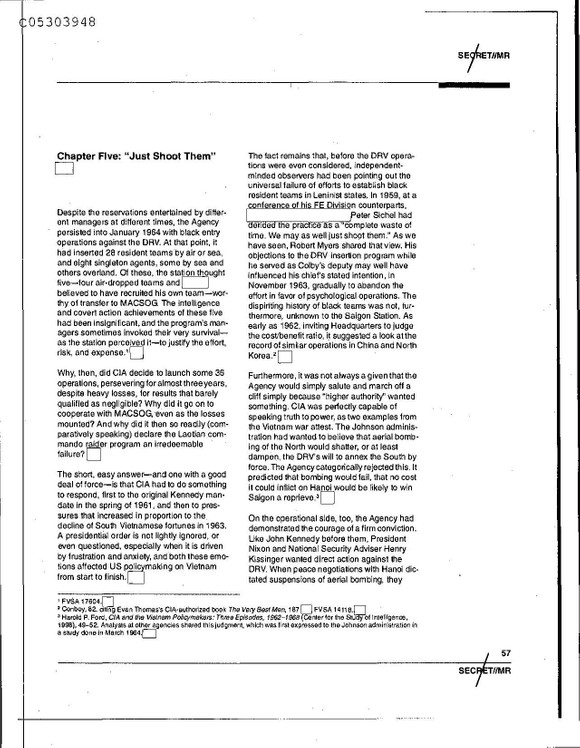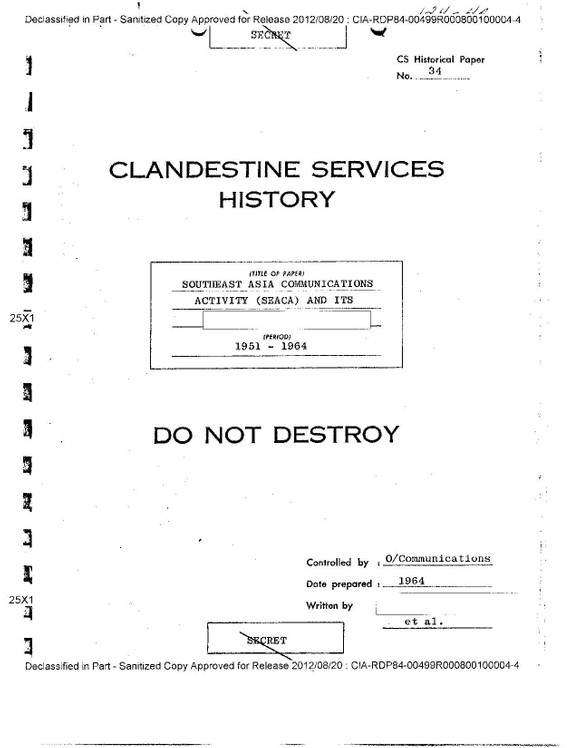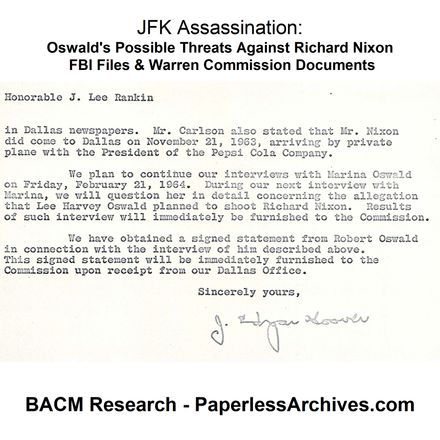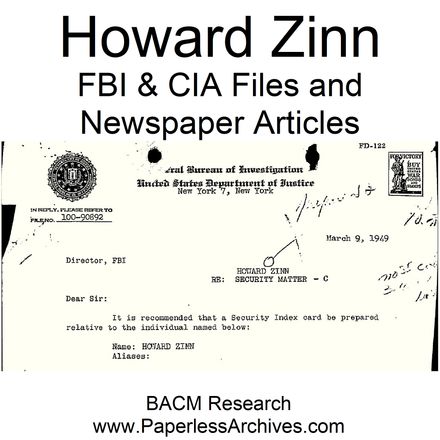Starting from:
$12.95
Vietnam War: CIA Official Internal Secret History Studies
Vietnam War: CIA Official Internal Secret History Studies
2,358 pages, 48 different documents, of once classified official history of the CIA’s involvement in Vietnam, produced by the History Staff of the Central Intelligence Agency, CIA historians and current and former CIA personnel.
This collection includes:
CIA and the House of Ngo: Covert Action in South Vietnam, 1954-1963 (2000)
This 228-page volume by CIA historian Thomas L. Ahern, Jr., begins with the early Agency activity in Vietnam, and ends with the 1963 assassination of President of South Vietnam Ngo Dinh Diem, which the CIA was aware, if not complicit and along with the Kennedy administration. This history shows that as late as the morning of the day the Diem coup, the U.S. military command in South Vietnam advised the CIA that nothing was happening in Saigon and that the agency should stop reporting that any coup was imminent. Ahern notes that CIA analysts recognized as early as August 1954 that Diem would have political problems, that the CIA went beyond headquarters guidance, and effectively set policy for supporting Diem, and that its relationship with his brother Ngo Dinh Nhu began as early as 1952.
Abstract: After the partition of Vietnam with the Geneva Agreements of 1954, the Eisenhower administration began to directly support the government in the South headed by Ngo Dinh Diem. President Eisenhower, in a letter to Diem, promised to help Diem maintain a "strong, viable state capable of resisting outside aggression." Armed with this support, in July 1954, Diem rejected the reunification elections provided for in the Geneva Agreements and declared South Vietnam a republic with himself as president. The CIA, although pessimistic about establishing a stable, civilian regime in South Vietnam, nevertheless set about assisting Diem in creating a new state. This is the story of CIA's efforts and its relationship with Diem and his brother Ngo Dinh Nhu.
Based on a thorough examination of CIA's records and on in-depth interviews of key participants, Thomas Ahem presents an authoritative review and assessment of CIA's evolving relationship with Diem, first as he struggled to consolidate his power and then as his increasingly authoritative regime faltered and collapsed when the South Vietnamese military seized power in a coup favored by the United States. The military generals assassinated Diem and his brother Nhu U.
This ultimately tragic drama is followed in detail by Ahem as he traces CIA efforts initially to aid Diem in forming a viable state. That this effort to build a modern nation state failed greatly frustrated CIA officers. Nevertheless, the CIA continued its efforts to influence and shape policies and programs in South Vietnam long after Diem's death.
CIA and the Generals Covert Support to Military Government in South Vietnam (1998)
This 245-page internal CIA history by Thomas L. Ahern, Jr., provides an overview of CIA efforts from South Vietnamese military coup that overthrew Saigon leader Ngo Dinh Diem to the fall of Saigon in 1975. A third of this study is devoted to the two-year period after the Paris Accords of 1973 and the evacuation of Saigon, which agency sources regard as the highlight of the work, according to Frank Snepp, author of "Decent Interval: An Insider's Account of Saigon's Indecent End Told by the CIA's Chief Strategy Analyst in Vietnam."
Ahern highlights how the Agency's relationship with Saigon leaders changed over time, depending on who was the CIA station chief, the U.S. ambassador, and the South Vietnamese leaders involved at the time. In the final period from about 1969, when Nguyen Van Thieu led the Saigon government, Ahern writes that "Thieu's mistrust of the U.S. increasingly focused on the CIA."
This study covers the CIA and South Vietnamese Buddhists, whom the CIA secretly supported and trained in 1965 and the substantial involvement by the CIA in the South Vietnamese elections of 1967 and 1971. Aherns covers how the CIA openly provided suggestions for a political platform, supporting individual candidates, using agents to counteract charges of electoral fraud, and manipulating the South Vietnamese National Assembly to certify election results. He cites as an important political initiative was the Agency's clandestine contact with the National Front for the Liberation of South Vietnam.
CIA and Rural Pacification in South Vietnam, Center for the Study of Intelligence (2001)
CIA historian Thomas Ahern 's 436-page account of the CIA's contribution to the US effort to establish and preserve a South Vietnam government. In this volume, Ahem describes the Agency's role in rural pacification and counterinsurgency. He details the changing programs and field operations and the Agency's attempts to win the "hearts and minds" of the South Vietnamese rural population.
Ahern tells this ultimately tragic story from the perspective of the CIA Saigon Station and the field operations. Using the original files of the Agency and making extensive use of oral history interviews, he describes the origins of the programs and traces their evolution. Ahern's study also strikingly illustrates the Clandestine Service culture, the clashes with Washington and the military, and the efforts of the men in the field as they struggled to establish viable counterinsurgency programs in the face of great odds.
The Way We Do Things: Black Entry Operations Into North Vietnam, Center for the Study of Intelligence (2005)
This 76-page monograph centers on CIA efforts to infiltrate agents of reconnaissance and sabotage teams into North Vietnam.
Undercover Armies: CIA and Surrogate Warfare in Laos, 1961-1973, Center for the Study of Intelligence, (2006)
This 598-page study by Ahern describe CIA's management of irregular warfare In Laos during the Vietnam conflict.
Good Questions, Wrong Answers: CIA's Estimates of Arms Traffic Through Sihanoukville, Cambodia, During the Vietnam War, Center for the Study of Intelligence, (February 2004)
Ahern's 52-page monograph on one of the most important intelligence disputes during the Vietnam war , the importance of the Cambodian port of Sihanoukville in supplying North Vietnamese and National Liberation Front (NLF) forces in the lower part of South Vietnam and the base areas located in contiguous parts of Cambodia.
CIA Clandestine Services Historical Series - Southeast Asia Communications Activity (SEACA) and its [redacted] 1951-1964 (1964)
CIA and the Wars in Southeast Asia 1947–75 (2016)
Power struggles in Saigon The CIA and the Government of Ngo Dinh Diem (1993)
Other material includes short reports, memos, CIA History Staff administrative files and articles from the CIA's internal journal, Studies in Intelligence. Material includes:
Memo - November 1963 - December 1964 Action Taken on the History of the Agency's Activities in Vietnam - January 26, 1965
CIA History Staff Monthly Report #1 - June 26, 1974
CIA History Staff Monthly Report #2 - July 31, 1974
CIA History Staff Monthly Report #3 - August 30, 1974
History Of Strength Estimates Of Viet Cong Irregulars - March 28, 1968
History Highlights 1949-74 - August 1, 1975
History of the Office of Training January 1966 - April 1969 - April 1, 1969
CIA History Program - April 30, 1974
Report of the History Advisory Committee - July 19, 1980
Intelligence in Small Wars (Lessons from Vietnam), by George W. Allen - Winter 1991 - 11-132-3
Vietnam in Retrospect, by Ellsworth Bunker Spring 1974 - 18-36-3
Intelligence Reform in the Mid-1970's, by Thomas S. Hardy Summer 1976 - 7-70-1
Re-Examining Our Perceptions on Vietnam, by Anthony Marc Lewis Winter 1973 17-35-1
US Intelligence and Vietnam. By General Bruce Palmer, Jr. Spring 1984 - 9-101-8
Rolling Thunder and Bomb Damage to Bridges, by Kenneth C. Fuller; Bruce and Atkins Merle Fall 1969 5-49-1
Recent Books Slow Burn The Rise and Bitter Fall of American Intelligence in Vietnam, by Orrin DeForest and David Chanoff Fall 1990 - 11-127-3
Crisis and Intelligence Two Case Studies (Tet and Iran), by Allen H. Kitchens Fall 1984 9-103-2
Recent Books The 25-Year War America's Military Role in Vietnam, by General Bruce Palmer, Jr. Summer 1985 9-106-6
Book Reviews A Station in the Delta, by John Cassidy Winter 1979 - 19-58-6
The LAMS Story (Research, Development, and Deployment of a Navigation System), by Martin C. Elkes Summer 1975 18-41-5
Quality Elint (Precision Measurement of the Operating Parameters of Uncooperating Radars), by William H. Nance Spring 1968 - 15-19-2
How Three Estimates Went Wrong (Some Lessons From Case Histories of Misjudgment in the NIEs), by Willard C. Matthias Winter 1968 15-18-3
A New Kind of Air Targeting, by William A Tidwell Winter 1967 - 4-42-3
The Vietnamese as Operational Target (Vulnerabilities Among the Viet Cong and North Vietnamese Elite), by Titus Leidesdorf Fall 1968 15-21-5
Counterintelligence in Counter-Guerrilla Operations, by M.H. Schiattareggia Summer 1962 - 13-23-1
Book Reviews: A Station in the Delta, by John Cassidy Winter 1979 - 19-58-6
Recent Books PAVN: People's Army of Vietnam, by Douglas Pike Fall 1986 - 9-111-9
Recent Books Intervention: How America Became Involved in Vietnam, by George McT. Kahn Winter 1986 10-112-6
Recent Books Why Vietnam? Prelude to America's Albatross Summer 1981 8-90-10



2,358 pages, 48 different documents, of once classified official history of the CIA’s involvement in Vietnam, produced by the History Staff of the Central Intelligence Agency, CIA historians and current and former CIA personnel.
This collection includes:
CIA and the House of Ngo: Covert Action in South Vietnam, 1954-1963 (2000)
This 228-page volume by CIA historian Thomas L. Ahern, Jr., begins with the early Agency activity in Vietnam, and ends with the 1963 assassination of President of South Vietnam Ngo Dinh Diem, which the CIA was aware, if not complicit and along with the Kennedy administration. This history shows that as late as the morning of the day the Diem coup, the U.S. military command in South Vietnam advised the CIA that nothing was happening in Saigon and that the agency should stop reporting that any coup was imminent. Ahern notes that CIA analysts recognized as early as August 1954 that Diem would have political problems, that the CIA went beyond headquarters guidance, and effectively set policy for supporting Diem, and that its relationship with his brother Ngo Dinh Nhu began as early as 1952.
Abstract: After the partition of Vietnam with the Geneva Agreements of 1954, the Eisenhower administration began to directly support the government in the South headed by Ngo Dinh Diem. President Eisenhower, in a letter to Diem, promised to help Diem maintain a "strong, viable state capable of resisting outside aggression." Armed with this support, in July 1954, Diem rejected the reunification elections provided for in the Geneva Agreements and declared South Vietnam a republic with himself as president. The CIA, although pessimistic about establishing a stable, civilian regime in South Vietnam, nevertheless set about assisting Diem in creating a new state. This is the story of CIA's efforts and its relationship with Diem and his brother Ngo Dinh Nhu.
Based on a thorough examination of CIA's records and on in-depth interviews of key participants, Thomas Ahem presents an authoritative review and assessment of CIA's evolving relationship with Diem, first as he struggled to consolidate his power and then as his increasingly authoritative regime faltered and collapsed when the South Vietnamese military seized power in a coup favored by the United States. The military generals assassinated Diem and his brother Nhu U.
This ultimately tragic drama is followed in detail by Ahem as he traces CIA efforts initially to aid Diem in forming a viable state. That this effort to build a modern nation state failed greatly frustrated CIA officers. Nevertheless, the CIA continued its efforts to influence and shape policies and programs in South Vietnam long after Diem's death.
CIA and the Generals Covert Support to Military Government in South Vietnam (1998)
This 245-page internal CIA history by Thomas L. Ahern, Jr., provides an overview of CIA efforts from South Vietnamese military coup that overthrew Saigon leader Ngo Dinh Diem to the fall of Saigon in 1975. A third of this study is devoted to the two-year period after the Paris Accords of 1973 and the evacuation of Saigon, which agency sources regard as the highlight of the work, according to Frank Snepp, author of "Decent Interval: An Insider's Account of Saigon's Indecent End Told by the CIA's Chief Strategy Analyst in Vietnam."
Ahern highlights how the Agency's relationship with Saigon leaders changed over time, depending on who was the CIA station chief, the U.S. ambassador, and the South Vietnamese leaders involved at the time. In the final period from about 1969, when Nguyen Van Thieu led the Saigon government, Ahern writes that "Thieu's mistrust of the U.S. increasingly focused on the CIA."
This study covers the CIA and South Vietnamese Buddhists, whom the CIA secretly supported and trained in 1965 and the substantial involvement by the CIA in the South Vietnamese elections of 1967 and 1971. Aherns covers how the CIA openly provided suggestions for a political platform, supporting individual candidates, using agents to counteract charges of electoral fraud, and manipulating the South Vietnamese National Assembly to certify election results. He cites as an important political initiative was the Agency's clandestine contact with the National Front for the Liberation of South Vietnam.
CIA and Rural Pacification in South Vietnam, Center for the Study of Intelligence (2001)
CIA historian Thomas Ahern 's 436-page account of the CIA's contribution to the US effort to establish and preserve a South Vietnam government. In this volume, Ahem describes the Agency's role in rural pacification and counterinsurgency. He details the changing programs and field operations and the Agency's attempts to win the "hearts and minds" of the South Vietnamese rural population.
Ahern tells this ultimately tragic story from the perspective of the CIA Saigon Station and the field operations. Using the original files of the Agency and making extensive use of oral history interviews, he describes the origins of the programs and traces their evolution. Ahern's study also strikingly illustrates the Clandestine Service culture, the clashes with Washington and the military, and the efforts of the men in the field as they struggled to establish viable counterinsurgency programs in the face of great odds.
The Way We Do Things: Black Entry Operations Into North Vietnam, Center for the Study of Intelligence (2005)
This 76-page monograph centers on CIA efforts to infiltrate agents of reconnaissance and sabotage teams into North Vietnam.
Undercover Armies: CIA and Surrogate Warfare in Laos, 1961-1973, Center for the Study of Intelligence, (2006)
This 598-page study by Ahern describe CIA's management of irregular warfare In Laos during the Vietnam conflict.
Good Questions, Wrong Answers: CIA's Estimates of Arms Traffic Through Sihanoukville, Cambodia, During the Vietnam War, Center for the Study of Intelligence, (February 2004)
Ahern's 52-page monograph on one of the most important intelligence disputes during the Vietnam war , the importance of the Cambodian port of Sihanoukville in supplying North Vietnamese and National Liberation Front (NLF) forces in the lower part of South Vietnam and the base areas located in contiguous parts of Cambodia.
CIA Clandestine Services Historical Series - Southeast Asia Communications Activity (SEACA) and its [redacted] 1951-1964 (1964)
CIA and the Wars in Southeast Asia 1947–75 (2016)
Power struggles in Saigon The CIA and the Government of Ngo Dinh Diem (1993)
Other material includes short reports, memos, CIA History Staff administrative files and articles from the CIA's internal journal, Studies in Intelligence. Material includes:
Memo - November 1963 - December 1964 Action Taken on the History of the Agency's Activities in Vietnam - January 26, 1965
CIA History Staff Monthly Report #1 - June 26, 1974
CIA History Staff Monthly Report #2 - July 31, 1974
CIA History Staff Monthly Report #3 - August 30, 1974
History Of Strength Estimates Of Viet Cong Irregulars - March 28, 1968
History Highlights 1949-74 - August 1, 1975
History of the Office of Training January 1966 - April 1969 - April 1, 1969
CIA History Program - April 30, 1974
Report of the History Advisory Committee - July 19, 1980
Intelligence in Small Wars (Lessons from Vietnam), by George W. Allen - Winter 1991 - 11-132-3
Vietnam in Retrospect, by Ellsworth Bunker Spring 1974 - 18-36-3
Intelligence Reform in the Mid-1970's, by Thomas S. Hardy Summer 1976 - 7-70-1
Re-Examining Our Perceptions on Vietnam, by Anthony Marc Lewis Winter 1973 17-35-1
US Intelligence and Vietnam. By General Bruce Palmer, Jr. Spring 1984 - 9-101-8
Rolling Thunder and Bomb Damage to Bridges, by Kenneth C. Fuller; Bruce and Atkins Merle Fall 1969 5-49-1
Recent Books Slow Burn The Rise and Bitter Fall of American Intelligence in Vietnam, by Orrin DeForest and David Chanoff Fall 1990 - 11-127-3
Crisis and Intelligence Two Case Studies (Tet and Iran), by Allen H. Kitchens Fall 1984 9-103-2
Recent Books The 25-Year War America's Military Role in Vietnam, by General Bruce Palmer, Jr. Summer 1985 9-106-6
Book Reviews A Station in the Delta, by John Cassidy Winter 1979 - 19-58-6
The LAMS Story (Research, Development, and Deployment of a Navigation System), by Martin C. Elkes Summer 1975 18-41-5
Quality Elint (Precision Measurement of the Operating Parameters of Uncooperating Radars), by William H. Nance Spring 1968 - 15-19-2
How Three Estimates Went Wrong (Some Lessons From Case Histories of Misjudgment in the NIEs), by Willard C. Matthias Winter 1968 15-18-3
A New Kind of Air Targeting, by William A Tidwell Winter 1967 - 4-42-3
The Vietnamese as Operational Target (Vulnerabilities Among the Viet Cong and North Vietnamese Elite), by Titus Leidesdorf Fall 1968 15-21-5
Counterintelligence in Counter-Guerrilla Operations, by M.H. Schiattareggia Summer 1962 - 13-23-1
Book Reviews: A Station in the Delta, by John Cassidy Winter 1979 - 19-58-6
Recent Books PAVN: People's Army of Vietnam, by Douglas Pike Fall 1986 - 9-111-9
Recent Books Intervention: How America Became Involved in Vietnam, by George McT. Kahn Winter 1986 10-112-6
Recent Books Why Vietnam? Prelude to America's Albatross Summer 1981 8-90-10



1 file (286.3MB)



